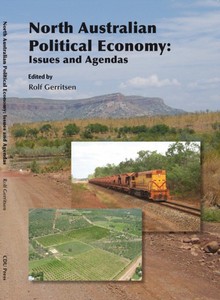The socio-economic features of northern Australia
Larson, Silva (2010) The socio-economic features of northern Australia. In: Gerritson, Rolf, (ed.) North Australian Political Economy: issues and agendas. Charles Darwin University, Darwin, NT, Australia, pp. 1-17.
![[img]](https://researchonline.jcu.edu.au/16016/1.hassmallThumbnailVersion/16016_Larson_2010_Book_Cover.jpg)
|
Image (JPEG) (Book Cover)
- Cover Image
Download (67kB) |
|
|
PDF (Published Version)
- Published Version
Restricted to Repository staff only |
Abstract
Socio-economically remote regions of Australia tend to be located in either arid or wet tropical bio-physical regions (Robin & Dovers, 2007; Stafford Smith 2008; Larson & Alexandridis 2009; Larson et al, 2010). Thus, remote and regional Australia appears to be different to the rest of Australia not only in socioeconomic, but also in bio-physical terms. To understand these regions better, one would need to understand the specific biophysical as well as socioeconomic drivers that shape them. One theoretical framework, developed by Stafford Smith (2008), proposes a set of key drivers that shape remote regions, and uses those drivers to explain the resulting key socio-economic characteristics of those regions. In his work, Stafford Smith concentrated on desert regions, and thus referred to his framework as a " Desert Syndrome". The hypothesis proposed in this chapter is that this theoretical framework is relevant not only to arid regions, but to any system that experiences similar states of the key drivers. The theoretical framework developed by Stafford Smith is of interest for two main reasons: it is interdisciplinary in nature, thus addressing characteristics of the social and economic system both as drivers in their own right as well as results of the primary biophysical drivers; and, the framework does not only propose key drivers but goes further and " predicts" the state that those drivers will manifest in a remote region. Indeed, recent writings on the framework (Stafford Smith & Huigen, 2009; Stafford Smith & Cribb. 2009), propose it be referred to as "desert system" rather than a "desert syndrome". An overview of the framework is presented below. The "desert system" theoretical framework proposes that remote dryland regions of Australia share a set of common characteristics that distinguish them from other regions in Australia (Figure 1.1 ). Variability, extremes and unpredictability of the climate, at various scales in space and time, result in low and variable primary productivity. In addition to the variability of climate, low productivity is also a result of scarcity of other resources. Those biophysical scarcities result in a sparse, mobile and patchy human population. The low human population mass in turn creates three main flow-on effects. First, low population numbers have little capacity to create significant local economic, political or cultural centres, thus resulting in distant markets and decision-making centres. Secondly, such regions typically attract little scientific and research effort, although they do tend to retain more traditional knowledge and culture and create more locally-relevant innovation. Last but not least, Stafford Smith (2008) proposes that such regions tend to drive the evolution of particular social arrangements and attract particular types or people. He hypothesises that the above drivers are causally linked in deserts in ways that are different to other environments, and thus proposes them as "desert drivers". This chapter proposes to test relevance of this framework, developed for arid regions, in the tropical rivers region. It explores data on each driver proposed in the framework, as well as the resulting states as observed in the tropical rivers region. To facilitate this exploration, the chapter is organized along the key characteristics of the proposed theoretical framework. The chapter closes with the discussion of the key characteristics of the northern region and the applicability of the "desert syndrome" theoretical framework in this context.
| Item ID: | 16016 |
|---|---|
| Item Type: | Book Chapter (Research - B1) |
| ISBN: | 978-0-9808641-0-6 |
| Date Deposited: | 27 Apr 2011 06:28 |
| FoR Codes: | 14 ECONOMICS > 1402 Applied Economics > 140299 Applied Economics not elsewhere classified @ 50% 16 STUDIES IN HUMAN SOCIETY > 1604 Human Geography > 160401 Economic Geography @ 50% |
| SEO Codes: | 91 ECONOMIC FRAMEWORK > 9199 Other Economic Framework > 919999 Economic Framework not elsewhere classified @ 50% 96 ENVIRONMENT > 9607 Environmental Policy, Legislation and Standards > 960799 Environmental Policy, Legislation and Standards not elsewhere classified @ 50% |
| Downloads: |
Total: 110 Last 12 Months: 3 |
| More Statistics |



